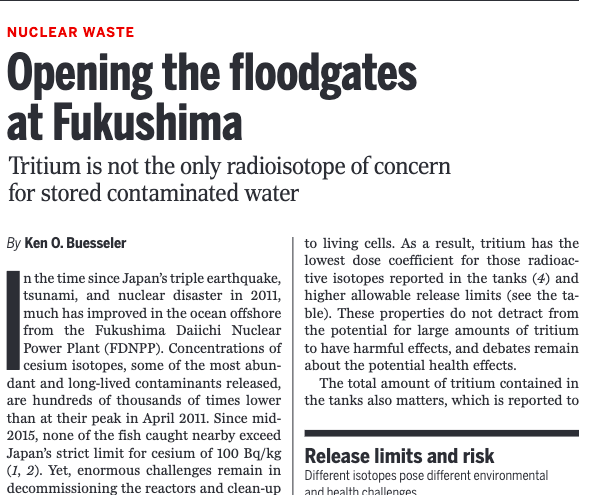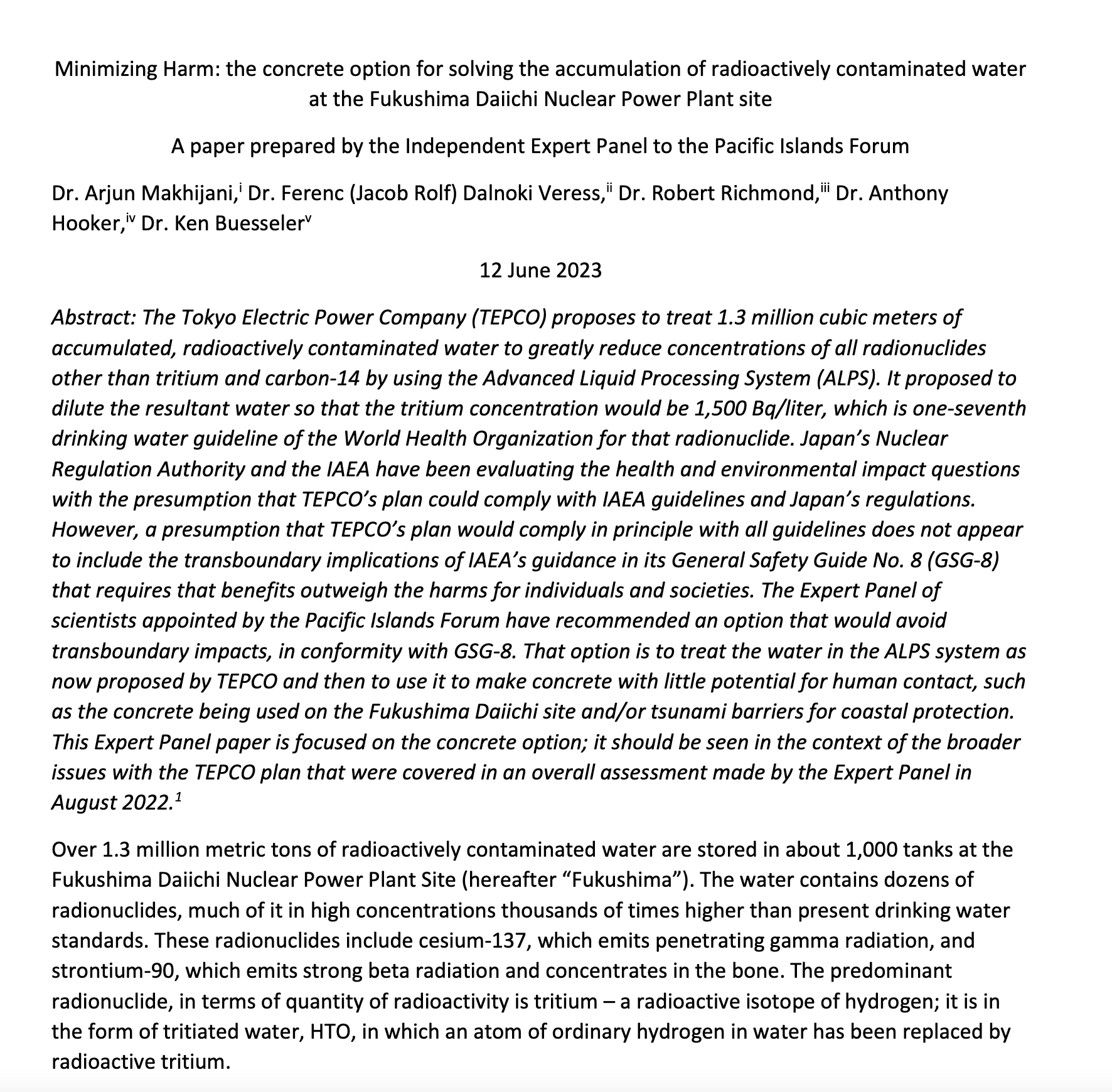Background
On March 11, 2011 a 9.0-magnitude earthquake triggered a 15 m (45 ft) tsunami inundating the Fukushima Dai-ichi Nuclear Power Plant (FDNPP). This caused a loss of power, explosions and multiple reactor meltdowns followed by the release of radioactive materials to the atmosphere. Over 80% of this fallout occurred over the ocean, with highest volumes close to the plant. There was also a discharge of contaminated cooling water into the ocean, making this FDNPP disaster the largest accidental input of radionuclides to the ocean. Since then, efforts have been made to reduce radioactive wastewater release into the surrounding environment. Part of this clean-up and decommissioning plan includes the release of wastewater currently stored in tanks at the coastal-located facility.
Current Status Summary
In the decade plus since the disaster, approximately 1000 tanks of radioactive waste water have accumulated at the powerplant site, containing more than 1 million tons of water just steps from the shoreline. The contents of these tanks are a combination of recovered contaminated groundwater, and cooling waters that have circulated through the damaged reactor and become enriched in many radioactive elements. Although decontamination systems have been implemented (e.g., multiple versions of an Advanced Liquid Processing System- ALPS), no set of systems can remove 100% of the present radioactivity, thus leaving wastewater that still could pose environmental risks. The wastewater is often noted for its enrichment in tritium, 3H, and contamination dispersal has been largely modeled after the behavior of tritium.
However, this story is also about the more dangerous isotopes that are still present in the tanks, such as ruthenium-106, cobalt-60, and strontium-90 (see TEPCO Treated Water Portal Site and Science article 2020). These isotopes pose a greater ecological risk than tritium because they are more readily incorporated into marine biota and seafloor sediments. TEPCO itself acknowledges that > 70% of the tanks would need secondary treatment to reduce concentrations of the these isotopes to be below the threshold they are considering for their release. Perhaps even more concerning is the information about isotope concentrations that is being omitted from TEPCO and the Japanese government about other radioactive elements, such as plutonium. A number of experts and stakeholders, such as the Pacific Islands Forum, oppose the release of wastewater until further information is made available.
Despite this lack of publicly available information, and demonstration of further wastewater radioactivity remediation treatment, the Japanese government plans to move ahead with wastewater releases into the Pacific Ocean later in 2023. The Japanese government and TEPCO argue that the presence of the wastewater tanks is hindering decommissioning efforts and pose risk in the event of another major earthquake or tsunami, and thus they cannot wait to release it. The current release plan involves transporting wastewater through a pipeline to a facility where it will be diluted with seawater, then sent through an undersea tunnel to be slowly released at an offshore location. This start date of executing this plan has been delayed several times.
We have been reviewing the situation considering the fate and possible impacts , and posted an argument against release at least until further information is made available on the contents of all tanks, verified by truly independent parties and for a much larger suite of radioactive elements required by their monitoring plans. For more information, see the links below on the current status of the FDNPP wastewater tanks and plans for releases.
Article Links
- U.S. oceanographer questions the data of Fukushima's nuclear contaminated wastewater; CGTN - June 2, 2023.
- Fukushima's fishing industry survived a nuclear disaster. 12 years on, it fears Tokyo's next move may finish it off; CNN - April 19, 2023
- Fukushima: Japan insists release of 1.3m tonnes of ‘treated’ water is safe; The Guardian - Feb. 14, 2023
- Despite opposition, Japan may soon dump Fukushima wastewater into the Pacific; Science - Jan 24, 2023
- In the Pacific, Outcry Over Japan’s Plan to Release Fukushima Wastewater; New York Times - Dec. 30, 2022
- The Pacific faces a radioactive future; 360 Environment - July 11, 2022
- Fukushima nuclear plant water to be released into the ocean via undersea tunnel; NBC - Aug. 25, 2021
- A quick read on the radioactive water in Fukushima – What makes it different? Greenpeace - April 28, 2021
Papers
- Minimizing the harm: the concrete option for solving the accumulation of radioactively contaminated water at the Fukushima Daiichi Nuclear Power Plant site (Makhijani, A., Dalnoki Veress, F., Richmond, R., Hooker, A., Buesseler, K.) June 12, 2023. For the Pacific Islands Forum.
- Opening the floodgates at Fukushima (K. Buesseler, Science)
Op-Eds
- Japan must work with the Pacific to find a solution to the Fukushima water release issue – otherwise we face disaster; Pacific Islands Forum - Jan. 4, 2023
- More data needed before ocean release of Fukushima water; Japan Times - Aug. 26, 2022
Reports
- Summary of Information and Data Gathered at Meetings and the Expert Panel’s Views; Pacific Islands Forum - Aug. 11, 2022
- Radiological Impact Assessment Regarding the Discharge of ALPS Treated Water into the Sea (Design stage) at the Fukushima Daiichi Nuclear Power Station; TEPCO - Nov. 17, 2021
- Safecast Daiichi Water Release Plan Report; Safecast - June 6, 2021

